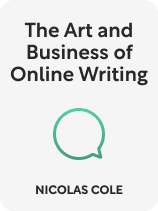

This article is an excerpt from the Shortform book guide to "The Art and Business of Online Writing" by Nicolas Cole. Shortform has the world's best summaries and analyses of books you should be reading.
Like this article? Sign up for a free trial here.
Have you ever wondered how to structure your online writing for maximum impact? Are you looking to improve your article organization skills?
In The Art and Business of Online Writing, Nicolas Cole shares valuable insights on crafting effective online content. He includes advice on organizing your piece into the three key article sections and explains how to create engaging openings, structure your main points, and conclude with impact.
Keep reading for Cole’s expert tips that can transform your articles into reader magnets.
Organize Your Piece Effectively
Cole says you must organize your online piece effectively so that it catches the reader’s attention. To do this, it must be clear and concise, as well as have a high rate of revelation—in other words, it should reveal new information quickly so the reader stays interested and feels they’re gaining something from reading. There are three main article sections that you must decide how to organize: the introduction, the body, and the conclusion.
(Shortform note: Cole’s advice on organization is primarily tailored toward article or blog-style writing, and therefore it isn’t always relevant to other online writing forms like novels or short stories. In On Writing, Stephen King contends that pushing for a high rate of revelation can ruin a novel—you need to strike a balance dependent on the story you’re telling and the feedback you get from readers of your first draft. Further, instead of having an introduction, body, and conclusion, works of fiction usually follow the five elements of plot: exposition, rising action, climax, falling action, and resolution.)
The Introduction
The introduction outlines what the piece is about and what it’s offering so readers can decide whether it’s relevant to them and if they trust you to provide good information. Cole says you should aim for your introduction to be five lines long:
(Shortform note: In works of fiction, your introduction would be replaced with the exposition of your story, in which you establish your main characters and the setting and start to reveal the main conflict of the story. Your exposition should usually only be a few chapters—keep it short, like Cole recommends doing with an introduction.)
1) One opening sentence: This sentence should aim to express the main point of the piece in roughly 10 words. For example, in an article titled “5 Signs Your Relationship Is Healthy,” your opening sentence might be: “Every healthy relationship depends on five key factors.”
(Shortform note: According to experts, the first line (sometimes the first few) of a work of fiction is just as important as the opening line of an article. This is your first opportunity to entice your reader, and there are a few techniques you can use to do so. For example, you can make your theme clear through an interesting statement, or offer a strange detail that piques the reader’s curiosity. Alternatively, you could show off your unique writing style as Vladimir Nabokov does in Lolita with the line “Lo-lee-ta: the tip of the tongue taking a trip of three steps down the palate to tap, at three, on the teeth.” His use of alliteration and figurative language tells readers to expect more of the like throughout the book.)
2) Three expanding sentences: These sentences should 1) clarify or elaborate on the opening sentence, 2) reinforce your point with a form of credibility (for example, a source or logic), and 3) wrap up the argument and prepare for the concluding sentence. For example: “Many relationships may have three or four of these five factors and be stable. However, being stable isn’t the same as being healthy. Lacking even one factor can create weakness in the dynamic that introduces the potential for major relationship issues to develop down the road.”
For longer or more complex pieces that may require further explanation in the introduction, you can include one or two additional descriptive sentences.
3) Concluding sentence: This should wrap up your point. For example, the concluding sentence of the relationship article could be, “It’s better to strengthen your relationship health now than face problems that could lead to a breakup later.”
(Shortform note: Cole’s strict five-line formula is his own unique brain-child. However, his format of using the middle sentences to explain and solidify the opening line, and the conclusion to wrap up your point, is similar to the traditional format of an essay. Traditional essay advice adds that you should look at your introduction as an upside-down triangle—each line after your opening sentence should clarify and narrow down your point until, in the conclusion, you state your thesis (or main point) for the piece.)
The Body
The body of your piece houses your main points. For example, the main points in the relationship article are the five signs you’re promising to discuss. Cole says the length and organization of each point in the body largely depends on how many points you’re making. To keep the reader engaged, the average length of a piece should be around 1,000—including more points means you have fewer words available to describe each one.
For example, if you have five points to make, each point can use the five-line format you used for your introduction: 1) Clearly state the point, 2) expand on or clarify the opening, 3) state why the reader should care (or why the point is important), 4) wrap up the argument, 5) conclude with why this point matters to your specific audience.
On the other hand, if you have 20 points, you’ll need to make the discussion of each point as short as possible to fit them all. For example, if the point is about having trust, you might say “Trust is a sign of a healthy relationship. Mutual trust makes both parties feel secure in the relationship. A lack of trust can lead to false accusations and hurt feelings, which put the relationship at risk.”
(Shortform note: Cole says you should aim to write shorter articles of around 1,000 words and adjust the length of each point in your body accordingly. However, some studies suggest that shorter articles aren’t always better. For example, a study done by HubSpot found that their most successful articles were between 2,250 and 2,500 words. So rather than trying to rush through each point in a 20-point article, it may be more engaging to your readers to give each point the description you think it deserves, even if that means your article goes well over 1,000 words.)
The Conclusion
Cole says there are three main ways you can conclude your piece:
1) A summary: This is most useful when your discussion is long or complex and readers may need a recap of the most important points.
2) A cliffhanger: This leaves the reader wanting more. Cliffhangers only require a few lines—imagine you’re metaphorically “dropping the mic.” For example, your conclusion in the relationship article might be: “These are the five factors that research tells us indicate relationship health. They may not be the only factors you need for your relationship to succeed, but they’re the ones that have the power to make or break your relationship.” This cliffhanger makes the reader want to know more—about how they can improve their relationship or what other factors they need to succeed. They’ll be likely to seek out more articles written by you.
3) A strong opinion: This is one of the best options if you want to end with a strong final point. The concluding point should connect all the points you’ve already made. For example, your final point in the relationship article could be: “If you want your relationship to last, you need to establish relational health at the start. Otherwise, you’re laying the groundwork for big issues later on.” You should organize this paragraph using the same format as a body paragraph.
| Writing a Resolution in Fiction Pieces The conclusions Cole discusses are specifically tailored toward nonfiction writing, but some of them may also be useful considerations when writing the resolution (conclusion) of a fiction piece. Resolutions typically have three main requirements: The story’s main conflicts are resolved, the characters arcs are completed, and any unanswered questions are answered. Providing a summary of the story’s plot points may not be an effective conclusion if you want to accomplish these three things; however, ending with a strong opinion may help you complete a character arc. For example, your main character can end with a philosophical statement (strong opinion) about any new perspectives or revelations they’ve acquired from their growth throughout the story. Just be sure you also use the resolution to resolve the conflict and tie up any loose ends. Cliffhangers are popular endings for stories if you plan to have a sequel, but they’re employed differently in fiction than in nonfiction. In fiction, cliffhangers are exceptions to the three main elements of resolution, since they often leave unresolved conflicts and unanswered questions. They usually end in one of two scenarios: Either the main character faces a threatening situation, or something shocking happens that threatens the course of the narrative. |

———End of Preview———
Like what you just read? Read the rest of the world's best book summary and analysis of Nicolas Cole's "The Art and Business of Online Writing" at Shortform.
Here's what you'll find in our full The Art and Business of Online Writing summary:
- The two things you must do to create a successful online writing career
- How often you should publish online
- Where to post your content for maximum impact






